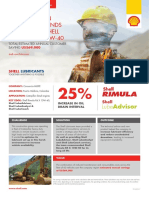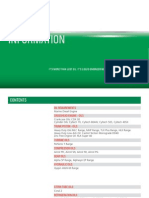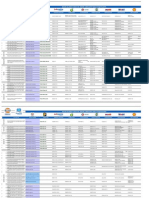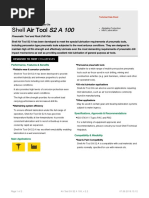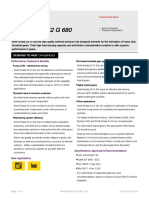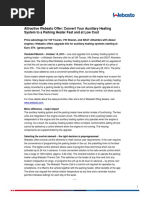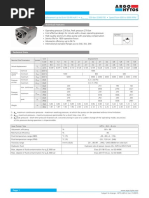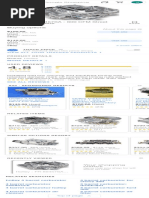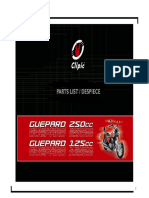Shell Lubricants ck4 and Fa4 Technical Brochure
Shell Lubricants ck4 and Fa4 Technical Brochure
Uploaded by
Raden ArdyCopyright:
Available Formats
Shell Lubricants ck4 and Fa4 Technical Brochure
Shell Lubricants ck4 and Fa4 Technical Brochure
Uploaded by
Raden ArdyOriginal Title
Copyright
Available Formats
Share this document
Did you find this document useful?
Is this content inappropriate?
Copyright:
Available Formats
Shell Lubricants ck4 and Fa4 Technical Brochure
Shell Lubricants ck4 and Fa4 Technical Brochure
Uploaded by
Raden ArdyCopyright:
Available Formats
Shell Lubricants
PREPARING FOR API CK-4 AND FA-4
WHAT THE NEW CATEGORIES MEAN
FOR YOU AND YOUR HEAVY-DUTY ENGINES
Technical brochure, May 2017
Shell_Lubricants_CK4_and_FA4_technical_brochure.indd 1 09/05/2017 09:44
2 TECHNICAL BROCHURE MAY 2017
Shell_Lubricants_CK4_and_FA4_technical_brochure.indd 2 09/05/2017 09:44
TECHNICAL BROCHURE MAY 2017 3
THE AMERICAN PETROLEUM
INSTITUTE (API) HAS CREATED
NEW CATEGORIES OF HEAVY-DUTY
DIESEL ENGINE OIL SPECIFICATIONS.
Shell has played a leading role in this process and has developed and tested
next-generation low- and high-viscosity oils that will meet the new specifications
without compromising oil life or wear protection. This technical brochure explores
the drive behind the new categories and what they mean for you and your
heavy-duty engines.
Shell_Lubricants_CK4_and_FA4_technical_brochure.indd 3 09/05/2017 09:44
4 TECHNICAL BROCHURE MAY 2017
ENABLING CHANGE
FOR MODERN ENGINES
Selecting the right oil is critical for The API has completely redesigned Despite this progress, there is a long way
heavy-duty-vehicle owners. There heavy-duty diesel engine oil specifications. to go. Recent regulations, coupled with
Shell has had a leading role in the new customers’ desires to reduce the total cost
are two new categories of heavy-
category development and, through more of ownership, are making fuel economy the
duty diesel engine oil specifications: than 64 million km of real-world testing, most critical driver for engine manufacturers.
both categories will reflect has demonstrated the performance of Advanced technologies and materials, and
improved engine performance and its next-generation, low‑viscosity oil new operating conditions such as higher
one category is specifically intended formulation technology. internal temperatures continue to improve
to deliver fuel economy benefits for engine efficiency.
EVOLUTION TO REVOLUTION
modern diesel engine technology. But oil and engine technology go hand in
Heavy-duty diesel engine designs have hand. Engine changes place more stress on
evolved substantially over the last 40 years. the oil, which has to lubricate, cool, clean
This evolution has been driven by emission and protect over extended oil-drain intervals.
legislation and customers’ requirements for
efficiency and reliability. There has been The vehicle industry is starting to recognise
significant progress. For example, high- that oil can help to achieve an engine’s
pressure, common-rail injection systems are full potential for fuel economy without
now widely used to improve combustion compromising hardware durability. As engine
efficiency; advances in turbocharger manufacturers create cleaner, more-fuel-
technology have increased specific power efficient diesel engines, they will need a new
output; and exhaust gas recirculation and generation of higher-performing diesel engine
aftertreatment devices, such as diesel oils to protect them.
particulate filters and selective catalytic
reduction, have curbed harmful emissions
of oxides of nitrogen and particulate matter
(i.e., soot).
Shell_Lubricants_CK4_and_FA4_technical_brochure.indd 4 09/05/2017 09:44
TECHNICAL BROCHURE MAY 2017 5
WHAT ARE THE NEW API
CK-4 AND FA-4 CATEGORIES?
DEFINING THE CATEGORIES They will be designed with improved
More than a decade has passed since oxidation resistance, shear stability and NEW OIL SPECIFICATIONS:
the last API diesel engine oil category, aeration control. API CK-4 VERSUS API FA-4
API CJ-4, was developed. During this ■ FA-42 oils will also meet these new
time, engines have changed considerably requirements and include lower viscosity
and have improved fuel consumption and grades designed for next-generation diesel
increased power outputs. New EPA and
NHTSA emission legislation scheduled
engines to help maximise fuel economy
without sacrificing engine protection.
CK-4
VS FA-4
for diesel-powered commercial transport These oils will have limited backwards
vehicles in 2017 requires significant compatibility because some older engines
CK-4 oils will have improved oxidation
improvements in fuel consumption that will were not designed to operate with lower resistance, shear stability and aeration control,
help to reduce carbon dioxide emissions. viscosity grades. and similar viscosity grades to API CJ-4
These fuel consumption improvements products. They are designed to replace oils for
These new engine oil requirements, current technologies and will have a minimum
depend on vehicle class, type and size,
especially for FA-4, are a major change high-temperature, high-shear (HTHS) viscosity
and include specific improvements for
in the industry’s approach to heavy-duty of 3.5 cP.
medium- and heavy-duty engines. This
oil specifications. However, the chemical FA-4 oils will have all the benefits of the
created the need for a new category of
limits used in CJ-4 oils will remain in place CK-4 formulations, but will be formulated to
lubricant specifications, collectively called have a lower HTHS viscosity (2.9–3.2 cP),
for CK-4 and FA-4 oils.3 Oil producers will
Proposed Category 11 (PC-11) during their therefore need expertise in formulating oils which is known to provide a fuel economy
development. The categories have been for the required performance and ensuring
benefit compared with oils having higher
officially named by the API as CK-4 and HTHS viscosities. As lower-viscosity oils can
that they continue to deliver excellent wear form thinner films, designing products for wear
FA-4. These oils will replace the current CJ-4 protection and cleanliness—two factors that protection will be critical for oil formulators.
heavy-duty oils. help to drive down customers’ maintenance
The API will introduce two types of heavy- costs and prolong engine life.
duty diesel oil as part of the new categories:
■ CK-41 oils will replace today’s lubricants
and will be completely backwards
compatible with all current diesel vehicles.
“The CJ-4 standard has lasted well beyond the life of the typical engine category. Some of
the engine tests required to qualify an oil are no longer available or no longer relevant to
next-generation engines.”
Dan Arcy, Global OEM Technical Manager
1
The name API CK-4 is the official name for the category, and it follows the naming convention of the API C series. This is the name that was given to the PC-11A development.
2
The name API FA-4 is the official name for the category and it will align with the future ACEA F category nomenclature for fuel economy oils. The term FA-4 will differentiate them
from API CK-4 oils. This is the name that was given to the PC-11B development.
3
Chemical limits were introduced with the use of diesel particulate filters to reduce particulate matter.
Shell_Lubricants_CK4_and_FA4_technical_brochure.indd 5 09/05/2017 09:44
6 TECHNICAL BROCHURE MAY 2017
NEW AND UPDATED TESTS MODIFIED LIMITS FOR OIL
A major part of designing an oil specification SHEAR STABILITY
is defining a set of rigorous tests that each oil Shear stability is a measure of an oil’s
formulation must pass before it goes on sale. ability to resist being sheared (mechanically
CK-4 and FA-4 specifications will continue degraded) under severe stress (Figure 1).
to use many of the current tests, but some of Shearing the polymer used in multigrade oils
these tests, such as shear stability, will have into smaller parts can reduce oil viscosity,
more stringent limits to reflect the needs of which may result in failure to protect vital
future engine hardware. Two new tests will engine parts.
ON- AND OFF-HIGHWAY be introduced to ensure that next-generation
CK-4 and FA-4 oils will have
oils can cope with the oxidation stability and
On-highway diesel emission to meet more stringent shear
aeration control needs of modern technology.
legislation generally leads off-highway stability limits.
emission requirements by several
years. On‑highway engines are used INCREASING SHEAR FORCE
to develop engine tests because they
are typically more advanced and use
less fuel than off-highway engines.
Engine manufacturers will determine
whether off-highway applications will
use FA-4 oils.
FIGURE 1a: An engine oil with low shear stability breaks down under high stress.
FIGURE 1b: Superior oils maintain their viscosity even in highly loaded contacts.
INCREASING SHEAR FORCE
Shell_Lubricants_CK4_and_FA4_technical_brochure.indd 6 09/05/2017 09:44
TECHNICAL BROCHURE MAY 2017 7
AERATION CONTROL FOR
MODERN TECHNOLOGY
Aeration is the inclusion of tiny air bubbles, or
foam, in the oil, which can impede its ability
to cool and protect an engine (Figure 2).
The higher operating temperatures, pressures
and oil flow in modern engines can increase
the amount of air entrained in lubricants. Oils
are also used more frequently as hydraulic
fluids for valve-train actuation: a task that may
be compromised by aerated oil. Consequently,
it is increasingly important for oils to have
excellent aeration control.
CK-4 and FA-4 oils will have to
pass a new Caterpillar engine oil
FIGURE 2: The formation of air bubbles in an oil formulation.
aeration test.
IMPROVED OXIDATION STABILITY
TO PROTECT HOTTER ENGINES
BASE OIL
Oxidation is the reaction of oil molecules
with oxygen. It can cause oil to degrade, RH ROOH KEY:
ROO* = peroxy radical
thereby decreasing its life and causing
R* = carbon radical
potentially damaging sludge and varnish,
Initiate Propagate
viscosity increase and corrosive wear.
Next-generation engines are designed to
operate at higher temperatures, which can R* ROO*
greatly accelerate oxidation rates. Terminate
Selecting the right base oils and antioxidant
additives can disrupt oxidation reactions and PRODUCTS
prevent the formation of harmful by-products
(Figure 3).
CK-4 and FA-4 oils will have to
pass a new oxidation stability test. O2 (oxygen) INSOLUBLE
SOLUBLE
Viscosity increase Varnish and sludge
FIGURE 3: Engine oil oxidation occurs via a radical chain reaction with oxygen. Antioxidants slow down ageing
by reacting with the radicals to disrupt degradation (red box).
Shell_Lubricants_CK4_and_FA4_technical_brochure.indd 7 09/05/2017 09:44
8 TECHNICAL BROCHURE MAY 2017
VISCOSITY AND FUEL ECONOMY Switching to a lower viscosity grade SAE oil, FA-4 XXW-30 oils will have HTHS viscosities
FA-4 oils will have lower viscosities for for example, from a 10W-40 to 10W‑30 between 2.9 and 3.2 cP, which will help
enhanced fuel economy. Even small oil, will provide modest fuel economy to enhance fuel efficiency further. Oil
increases in fuel economy can result in benefits. Even within a viscosity grade, companies and engine manufacturers are
significant reductions in fuel consumption differences in HTHS viscosity could affect currently testing these products, which are
and carbon dioxide emissions. For example, fuel economy. The minimum HTHS viscosity designed to provide fuel economy without
every EU truck increasing its fuel economy for current XXW-30 CJ-4 and future CK-4 oils sacrificing engine protection, in a range of
by just 1% would see an annual reduction is 3.5 cP. applications.
of over 4 million tonnes of carbon dioxide
emissions, which is the equivalent of Sets SAE winter viscosity grade: Sets SAE viscosity grade:
removing 23,000 trucks from the road. 0W TO 25W 08 TO 60
This would save fleet and owner operators
combined an estimated $3 million a day.4
Lower-viscosity oils pump more easily and
help to reduce engine friction, which can 1. 4.
improve fuel economy. However, there are
High shear-rate
different types of viscosity measurements that
Low-temperature viscosity
contribute to an engine oil’s viscosity grade.
pumping viscosity (HTHS)
Critically, it is the HTHS viscosity (defined 3.
as an oil’s resistance to flow under high
stress conditions at operating temperatures) Low shear-rate
that will distinguish backwards compatible kinematic
CK-4 oils from the fuel-economy FA-4 oils for 2. viscosity
modern engines. (KV100)
WHAT IS HTHS VISCOSITY? Low-temperature
cranking viscosity
Society of Automotive Engineers (SAE) oil
viscosity grades are defined by four different
tests (Figure 4). Low-temperature pumping
and cranking viscosities define the winter
grade (for example, the 15 in 15W-40).
HTHS dynamic viscosity contributes to the
SAE viscosity grade definition (for example, 1. Resistance to pumping in cold conditions: determines an oil’s ability to circulate
the 40 in 15W-40). Low shear kinematic through the engine.
viscosity (KV100) contributes to the definition
of monogrades, and provides a viscosity 2. Oil viscosity in crankshaft bearings during cold start up: determines performance
range for high-temperature viscosity grades of oils at low temperature.
in multigrade oils.
3. Internal resistance to flow. Minimum value sets the SAE winter grade; the range
determines the SAE viscosity grade.
4. Resistance to flow between narrow moving parts; mimics crankshaft and
connecting rod bearing lubrication.The SAE viscosity grade specifies a
minimum HTHS viscosity value.
FIGURE 4: Viscosity grade tests.
4
EIA –US Energy Information Administration – 2012 On-highway fuel sales. Calculation based on 1% of 36.34 billion gallons of fuel consumed annually at $3.00/gallon.
Shell_Lubricants_CK4_and_FA4_technical_brochure.indd 8 09/05/2017 09:44
TECHNICAL BROCHURE MAY 2017 9
To measure the effect of lubricant viscosity
on fuel economy, Shell has used a
proprietary in-house driveline test rig. The
5
experiments have shown that fuel economy
benefits vary with engine speed and load,
and, therefore, driving conditions. For
example, for a specific heavy-duty engine, 4
switching from a 15W-40 CJ-4 oil with a
Fuel economy benefit (%)
3.9-cP HTHS viscosity to a 10W-30 oil with
a FA-4 (2.9-cP) HTHS viscosity provides a 3
fuel economy improvement of about 1% in
high-speed high-load driving conditions and
up to 4% at low-speed, low-load driving 2
conditions (Figure 5). Manufacturers are
also using this information to design modern
engines, for example, downspeeding the
1
engine to improve fuel economy.
0
0
1,000 1,500
1,000
Torque (Nm) 2,000 500 Speed (rpm)
FIGURE 5: The fuel economy benefit of a 10W-30 oil with a FA-4 (2.9-cP) HTHS viscosity compared with
a 15W-40 CJ-4 oil with a 3.9-cP HTHS viscosity in a heavy-duty diesel engine, as measured using a Shell
proprietary driveline test rig.
Shell_Lubricants_CK4_and_FA4_technical_brochure.indd 9 09/05/2017 09:44
10 TECHNICAL BROCHURE MAY 2017
DEVELOPING A NEW HEAVY-DUTY
DIESEL ENGINE OIL SPECIFICATION API EMA
■ Language ■ Proposes tests
THE ROAD MAP TO THE NEW ■ Licensing ■ Provides hardware
■ Base oil interchange (BOI) ■ Reference oils
CATEGORIES
and viscosity grade read across ■ Category targets
The road to a new engine oil category is (VGRA) guidelines
long and complex. A three-phase process is
defined in API 1509 for the development of
the new category.
NEW CATEGORY DEVELOPMENT TEAM (NCDT)
In Phase 1, the New Category Evaluation
API, ACC, EMA and liaison members (ILMA, SAE, ASTM)
Team (NCET) is formed, which consists of
manage development of new category by a consensus process
manufacturers (EMA), oil marketers (API)
and additive companies (ACC, American
Chemistry Council). The focus of the NCET,
through a consensus process, is to review
ASTM ACC
the request and evaluate the need for a
■ Co-ordinates test development ■ Template guideline
new specification. ■ Establishes performance limits ■ Code of practice
Phase 2 consists of the formation of the New
Category Development Team (NCDT) to FIGURE 6: Structure of the NCDT.
oversee the specification and test method
development, and to agree to any additional GENERAL
guidelines (Figure 6). The NCDT is structured 2011 2012 2013 2014
with four functional work groups that report to
NHTSA and EPA agree new NCDT begins to oversee
the NCDT. Each of the four groups, consisting regulations for medium- and development of new test
of API, ASTM, ACC and EMA, have specific heavy-duty engines methods for PC-11 engine oils,
which are to become the
responsibilities. In addition, ad hoc work NCET proposes new oil API CK-4 and FA-4 categories
groups from SAE and engine test laboratories category to API lubricants
committee
are asked to participate. The NCDT works
through a consensus process to develop the
category.
Shell has played a leading role in
the development of the new engine
Shell Shell
oil categories: Dan Arcy, who acted Rimula Rimula
as NCDT Chair, is a member of the
Shell heavy-duty engine oil team.
Phase 3 of the development is the category
implementation.
SHELL
Dan Arcy elected NCDT chair Shell initiates field testing of Shell begins an extensive
prototype CK-4 and FA-4 lubricants, laboratory and engine test
Shell initiates field testing of including for on- and off-highway additives screening programme to
low HTHS viscosity oils in equipment and potential deliver a high standard of
preparation for FA-4 technologies for engine teardown performance for CK-4 and FA-4 oils
Shell works with engine
manufacturers to conduct engine
tests of low HTHS viscosity oils
to evaluate durability
FIGURE 7: Road map of the development 2011 2012 2013 2014
of CK-4 and FA-4.
Shell_Lubricants_CK4_and_FA4_technical_brochure.indd 10 09/05/2017 09:44
TECHNICAL BROCHURE MAY 2017 11
FIGURE 8: Shell has launched www.shell.com/rimula/ck4 to keep customers up to date with the
development of the new API category.
2014 2015 2016 2017
API Lubricants Group New greenhouse gas
SAVE AN ESTIMATED
approves names of CK-4
and FA-4 for the categories
legislation comes into effect $500,000 A DAY
New engine technology
CK-4 and FA-4 final launched
If all EU trucks in Germany increased their
specifications issued
fuel economy by 1%, fleet and owner
ASTM Heavy Duty Engine Oil
Classification Panel approves
operators would save an estimated
engine tests and pass/fail $500,00 a day and reduce carbon
criteria for API CK-4 and FA-4 dioxide emissions by over 700, 000 t/y,6
CK-4 and FA-4 oils licensed5 based on 150,000 km/y and an oil-drain
interval of 21 weeks.
Shell
a Rimula
5
1 December, 2016
6
Number of trucks in Germany =
307,000 (source: The International
Shell conducts a live teardown of Shell reaches 64 million real-world Council on Clean Transportation, EU
market statistics); average cost of diesel
an engine from low HTHS viscosity kilometres on low-viscosity FA-4 type in Germany = US$1.325 (source:
oil field trials in front of the media heavy-duty engine oil field trials globalpetrolprices.com)
Shell completes an extensive Shell plans to conduct 16–24
component screening programme million kilometres of additional
involving more than 20 engine tests testing on API FA-4 oils
2014 2015 2016 2017
Shell_Lubricants_CK4_and_FA4_technical_brochure.indd 11 09/05/2017 09:44
12 TECHNICAL BROCHURE MAY 2017
LABORATORY TO ROAD:
MAKING CK-4 AND FA-4 A REALITY
In addition to helping to lead the new WEAR PERFORMANCE OF PROTOTYPE CHEMISTRIES
category development, the Shell heavy‑duty
CK-4 and FA-4 limit
engine oil team has already been creating
new oils targeted to meet the CK-4 and Legacy product
FA-4 specifications. The main challenges
are to satisfy the stringent new performance Chemistry A
requirements and to ensure that engine
cleanliness and wear protection are Chemistry B
maintained in future engine hardware. All this
Chemistry C
must be achieved within strict chemical limits
for exhaust aftertreatment compatibility. Chemistry D
For CK-4 oils, optimising the oil composition
Chemistry B+C
for antioxidant and viscosity modifier
chemistry combinations that will meet Chemistry B+D
shear stability requirements is critical for
success. An additional challenge for the BETTER PERFORMANCE
lower-viscosity FA-4 oils is to balance
FIGURE 9: CK-4 engine screening tests show that combinations of prototype anti-wear additives
these requirements with the right anti-wear
could exceed CK-4 requirements and the performance standard of a legacy product.
components for wear protection with thinner
oil films.
The Shell team has many decades of
experience of developing high-quality
products that have been tried and tested
in the field. Shell has invested millions of
dollars in testing and development. To date,
the team has performed more than 9,000
tests using proprietary test rigs and external
engine test rigs in collaboration with engine
manufacturers in order to understand the
CK-4 and FA-4 formulation requirements.
FIGURE 10: The unique slide/roll rig test, which FIGURE 11: The optical profilometer uses
Lubricants are complex mixtures of base was designed by Shell, is a good simulation of a laser as a non-destructive way to measure
diesel engine wear tests. It is used to screen a wear. It is enabling Shell scientists to evaluate
oils and additives, and getting the right
wider range of candidate oil chemistries in a product wear performance more precisely than
balance of components requires significant shorter time than full engine tests would enable. conventional methods.
expertise and extensive screening in the The best technologies are then tested further in
laboratory and on the road. Shell scientists selected engine tests.
have designed and screened prototype
oils to optimise additive chemistry in
combination with high-quality base oils
(Figure 9). They recognise that selecting the
right additive chemistry is about finding the
right component combinations that will help
next‑generation Shell Rimula engine oils to
meet and exceed the demanding targets of
the CK-4 and FA-4 categories.
Shell_Lubricants_CK4_and_FA4_technical_brochure.indd 12 09/05/2017 09:44
TECHNICAL BROCHURE MAY 2017 13
GOING THE DISTANCE:
64 MILLION KM AND COUNTING
64
It is not enough to evaluate prototype oils
in the laboratory: the real test is how they
work in on- and off-road vehicles in the real
world. Field trials are an integral part of the
Shell engine oil technology development
process. They are extensive programmes run
in collaboration with customers and require
scientific rigour, experience and expertise.
Shell performs millions of kilometres of
real-world testing with customers (Figure MILLION KM
12). Between 2006 and 2015, Shell
provided more than 270,000 L of lubricants 400 TRUCKS
for use in customer field tests. A special Mining
focus has been placed on a subset of
more than 50 engines, which have been
Agriculture
thoroughly inspected. These engines
received additional attention and were part
Construction
of a teardown programme to inspect parts
following significant distance accumulation.
Long haul
A heavy-duty vehicle on the road is
expected to meet 1.6 million km of life
Short haul
without engine failure. Although some
wear is normal, higher levels can indicate FIGURE 12: Shell real-world testing with customers.
durability issues. Shell has tested engines from a variety of equipment
manufacturers, including Cummins, Detroit Diesel,
During each trial, oil samples are taken Mack, Navistar, Paccar and Volvo.
and analysed to evaluate the oil’s wear-
protection and viscosity performance. Used of testing on low HTHS viscosity oil. The
oil analysis can also provide information, for field trials cover all the major manufacturers’
example, about coolant leaks, which can on-highway engines and in different vehicles
be used for preventive maintenance. with diverse duty cycles. Positive wear
protection results have been recorded.
FA-4 oils have lower viscosities, and
therefore form thinner oil films, than any In addition to used oil analysis during field
products currently on the market, so ensuring trials, Shell engineers teardown field trial
that they provide good wear protection engines, sometimes in collaboration with
is critical. Shell has assessed the wear manufacturers and customers, to inspect and
protection performance of low-viscosity quantitatively rate engine component wear
oils in the field for several years and and thus evaluate the oil’s ability to protect
demonstrated that low HTHS viscosity oils critical hardware. For trucks running on low
can deliver effective wear protection and HTHS viscosity oils, 14 engine teardowns
long oil life. By the beginning of 2016, Shell have been performed, including two in front
had performed more than 64 million km of the media.
Shell_Lubricants_CK4_and_FA4_technical_brochure.indd 13 09/05/2017 09:44
14 TECHNICAL BROCHURE MAY 2017
FA-4 VERSUS CURRENT
Commercial CJ-4 15W-40
TECHNOLOGY: AN 800,000-KM
Commercial CJ-4 10W-30
EXAMPLE (CK-4 HTHS)
Prototype 10W-30
As part of the extensive field programme, (FA-4 HTHS)
a fleet of vehicles with 2011 Detroit DD15
Iron in engine oil
engines was tested over multiple oil-drain
intervals and more than 800,000 km to
compare current 15W-40 and 10W-30
CJ-4 oils with a prototype (FA-4) low HTHS
viscosity 10W-30 oil. In addition, in June
2015, a Detroit DD15 engine running a
low HTHS oil with more than 1.2 million km
was inspected and compared with a similar
engine running a 15W-40 viscosity oil.
Used engine oil analysis showed that the
low HTHS viscosity oil compared with the 0 250,000 500,000 750,000 1,000,000 1,250,000
current oil, offers Engine km
■ the same wear performance (Figure 13)
■ similar ageing characteristics (Figure 14).
Commercial CJ-4 15W-40
Engine teardowns show Commercial CJ-4 10W-30
(CK-4 HTHS)
■ no discernible difference in wear
Prototype 10W-30
performance (Figure 15). (FA-4 HTHS)
Aluminium in engine oil
Currently, Shell is working on the FA-4
formulation and making sure that the
product not only meets but also exceeds the
FA-4 specification, which has built-in fuel
economy wins.
0 250,000 500,000 750,000 1,000,000 1,250,000
Engine km
FIGURE 13: The wear rates for iron (top) and aluminum (bottom) were nearly identical for all three oils. In all three
cases, microscopic wear particles show early break-in wear followed by a reduction to a consistent low wear rate.
Shell_Lubricants_CK4_and_FA4_technical_brochure.indd 14 09/05/2017 09:44
TECHNICAL BROCHURE MAY 2017 15
“In more than 64 million km of real‑world
field testing, we are seeing promising
performance and durability for low-
Kinematic viscosity (100°C)
viscosity FA-4 oils. Customers using
Commercial CJ-4 15W-40
Shell Rimula products can be assured
Commercial CJ-4 10W-30
(CK-4 HTHS) that we are committed to delivering
Prototype 10W-30 next-generation engine oils that will
(FA-4 HTHS)
provide the opportunity to reduce fuel
consumption without compromising the
products’ excellent wear protection.”
Matt Urbanak, Team Leader for Heavy Duty
Engine Oil Development, Shell Lubricants
0 40,000 80,000 120,000 160,000
Oil-drain km
FIGURE 14: The rate of viscosity increase throughout the oil-drain interval is similar for all three oils (shown by the
similar gradient of the lines). Oxidation is a major cause of viscosity increase, which indicates oil ageing.
FIGURE 15: No discernible difference in
wear was observed between engines using the
prototype low HTHS viscosity oil and the two
higher viscosity oils. In fact, the engine using the
prototype oil had a notable lack of wear. The cam
lobe, piston and wrist pin bushings pictured here
were observed to be in a very good state after
running for 837,499 km with the prototype oil.
The contact areas of these components are critical
for wear protection, as they are subjected to
extreme pressures with high heat and friction.
Shell_Lubricants_CK4_and_FA4_technical_brochure.indd 15 09/05/2017 09:44
16 TECHNICAL BROCHURE MAY 2017
BEYOND API CK-4 AND FA-4:
LOOKING TO THE FUTURE
There is a worldwide need to improve
heavy-duty engine fuel efficiency. The
introduction of CK-4 and FA-4 is another
milestone on the road to greater efficiency.
As global fuel economy targets and the
associated penalties for failing to meet
them become increasingly important for
manufacturers, they will turn more and
more to engine oil as a critical enabling
technology. Getting this right requires out-
of-the box thinking and long-term technical
partnerships.
STUDYING SOOT
For example, Shell is sponsoring a PhD
project at Imperial College London, UK, to
further understanding of the mechanisms
behind soot-induced engine wear using
a range of state-of-the-art experimental FIGURE 16: Carbon-black aggregates formed during the combustion process can play a
techniques (Figure 16). Soot produced in significant role in engine wear.
diesel engines can promote wear, so it
is critical to employ the correct lubricant
chemistries to mitigate this issue. In addition, the anti-wear additives. The insights gained
selecting the optimum dispersant system plays in this project, including the identification of
a significant role in keeping soot particles strong-performing anti-wear and dispersant
dispersed in the oil, so it is important to combinations, will help Shell in formulating
understand how dispersants interact with better lubricants for current and future needs.
Shell_Lubricants_CK4_and_FA4_technical_brochure.indd 16 09/05/2017 09:44
TECHNICAL BROCHURE MAY 2017 17
CONCLUSION:
CK-4 AND FA-4 WITH PEACE OF MIND
The drive for fuel efficiency comes from
greenhouse gas emissions legislation and the MEET THE SHELL HEAVY-DUTY ENGINE OIL TEAM
ever-present need for successful businesses
and customers to cut operating costs. Engine
technology continues to evolve and engine Dan Arcy
manufacturers and regulators recognise Global OEM Technical Manager
that engine oil, along with developments in
Dan was elected chair for the API NCDT responsible for CK-4
engine technology, will power the delivery
and FA-4 after decades of involvement with API. He is also
of enhanced fuel efficiency.
responsible for technical relationships with major equipment
A major milestone along the road to manufacturers in the US market.
ever‑greater fuel economy will be the launch
of a new specification category API CK-4, for
backwards compatible oils, and the inclusion Matt Urbanak
of another category for low-viscosity, heavy-
Team Leader, Heavy-Duty Engine Oil Development
duty engine oils (API FA-4).
Matt is a leading member of the heavy-duty engine oil team. He
Shell had a leading role in the development
has worked on several previous categories and is heavily involved
of CK-4 and FA-4. The new specifications
in formulation and field trial programmes for CK-4 and FA-4.
set more stringent shear stability limits and
new tests for aeration control and oxidation
stability. In addition, the new specifications
for FA-4 will set low HTHS viscosities for
greater fuel efficiency. Howard Hill
Heavy-Duty Engine Oil Field Trial Engineer
A key concern for operators is whether
lower-viscosity oils can reduce fuel costs and Howard leads Shell’s field trial programme in the USA and is an
carbon dioxide emissions while providing the independently qualified engine rater. He has conducted several
long oil-drain intervals and reliable engine hundred inspections for heavy-duty engines during his 36 years
protection required to keep down the total cost with Shell.
of ownership.
Extensive laboratory screening has helped
Dr Jason R. Brown
Shell to formulate promising FA-4 prototype oils
efficiently. Millions of kilometres of road testing Global Technology Manager, Heavy-Duty Engine Oil
have since demonstrated that engine durability Jason manages the technology programme for the Shell Rimula
is not significantly compromised through using and Shell Rotella portfolios. He has been part of the heavy-duty
these low HTHS viscosity oils. Fuel economy engine oil team for almost a decade and deeply involved in
demonstrations have come through specific understanding formulations and leading product development.
test protocols using highly statistical test Jason is very excited about the challenge of developing fuel
methodologies. These oils offer the potential economy oils for the next API category.
for significant fuel savings while matching the
oil life and wear protection performance of
today’s leading commercially available oils.
called ACEA F8 and F11 respectively. The
In Europe, the Association des Constructeurs introduction of lower HTHS specifications to
Européens d’Automobiles (ACEA) is expected ACEA may result in the addition of new tests
to introduce new specifications aligned with to reflect the changes in modern heavy-duty
API FA-4. ACEA 2018 will most likely include engine hardware. These may include a low
updates of ACEA E6 and E9 with lower soot wear test as well as the new Volvo T13
HTHS viscosities, which will potentially be oxidation test.
Shell_Lubricants_CK4_and_FA4_technical_brochure.indd 17 09/05/2017 09:44
18 TECHNICAL BROCHURE MAY 2017
ENGINE TECHNOLOGY CONTINUES TO EVOLVE
AND ENGINE MANUFACTURERS AND REGULATORS
RECOGNISE THAT ENGINE OIL, ALONG WITH
DEVELOPMENTS IN ENGINE TECHNOLOGY, WILL
POWER THE DELIVERY OF ENHANCED FUEL EFFICIENCY.
Shell_Lubricants_CK4_and_FA4_technical_brochure.indd 18 09/05/2017 09:44
TECHNICAL BROCHURE MAY 2017 19
Shell_Lubricants_CK4_and_FA4_technical_brochure.indd 19 09/05/2017 09:44
CONTACT US
www.shell.com/rimula
Shell_Lubricants_CK4_and_FA4_technical_brochure.indd 20 09/05/2017 09:44
You might also like
- Mitsubishi Galant 1998Document47 pagesMitsubishi Galant 1998Artur KrzyżanowskiNo ratings yet
- Manual de Bombas Fuller Tipo MDocument35 pagesManual de Bombas Fuller Tipo MSergio Treviño Gonzalez50% (2)
- Tafe Company IntroductionDocument12 pagesTafe Company IntroductionsanjuNo ratings yet
- Mobil ATF 333Document2 pagesMobil ATF 333ppanagos5664No ratings yet
- Product Nomenclature and Basics of Diesel EnginesDocument33 pagesProduct Nomenclature and Basics of Diesel Enginesfreddy yagualNo ratings yet
- Fuchs Price List - FinalDocument9 pagesFuchs Price List - FinalLightingmania0% (1)
- Diesel Engine Oil - KomatsuDocument2 pagesDiesel Engine Oil - KomatsuRaden ArdyNo ratings yet
- FORD Zetec Engine Parts List - 01Document4 pagesFORD Zetec Engine Parts List - 01cpaolinodNo ratings yet
- Shell - Rimula - R4 X 15W40 - Construction ColombiaDocument1 pageShell - Rimula - R4 X 15W40 - Construction ColombiaJorge Arrieta Torres100% (1)
- Engine Oils: Hitec® 12210Document2 pagesEngine Oils: Hitec® 12210Muhammad WaqasNo ratings yet
- Oem Approval Listings: Shell LubricantsDocument30 pagesOem Approval Listings: Shell LubricantsWajahat RasoolNo ratings yet
- Bechem Ceritol Psa 12 H PDSDocument1 pageBechem Ceritol Psa 12 H PDSVirender KumarNo ratings yet
- Brugarolas Food Industry CatalogueDocument4 pagesBrugarolas Food Industry CataloguenghiaNo ratings yet
- SG 460-SSDocument1 pageSG 460-SSvarunNo ratings yet
- Proof of Performance Mobilith SHC 1500 Zahnradkupplung in Kohleminen EngDocument1 pageProof of Performance Mobilith SHC 1500 Zahnradkupplung in Kohleminen EngLaurent GuyotNo ratings yet
- Rimula R5 NG in Fleet DVRDocument1 pageRimula R5 NG in Fleet DVRRaden Ardy100% (1)
- Chlorine Free Neat Cutting OilsDocument2 pagesChlorine Free Neat Cutting OilsDANIEL ZORRONo ratings yet
- VELVEX - Automotive LubesDocument4 pagesVELVEX - Automotive LubesVaradrajan jothiNo ratings yet
- STLE2018 - CMF VI - Session 6B - P. Rabbat - BASF PAG-Based Finished Lubricant Solutions PDFDocument18 pagesSTLE2018 - CMF VI - Session 6B - P. Rabbat - BASF PAG-Based Finished Lubricant Solutions PDFHiMichael LiangNo ratings yet
- Is 13656 2002 PDFDocument24 pagesIs 13656 2002 PDFSiddharth GuptaNo ratings yet
- PSC Specialty Lubricant 2021Document43 pagesPSC Specialty Lubricant 2021Project Sales CorpNo ratings yet
- Lubricantes LSCDocument22 pagesLubricantes LSCAndres PozoNo ratings yet
- Base Oil White Oil Ultra Series Group IIIDocument1 pageBase Oil White Oil Ultra Series Group IIIAbe KobNo ratings yet
- Catalogo CastrolDocument45 pagesCatalogo Castrolggpp13100% (2)
- WTP 40Document26 pagesWTP 40Alok ChaurasiaNo ratings yet
- LGHP 2Document2 pagesLGHP 2F CNo ratings yet
- Molykote For Sugar Mill Machinery Call +91-98851-49412Document4 pagesMolykote For Sugar Mill Machinery Call +91-98851-49412Project Sales CorpNo ratings yet
- Synthetic Lubricants FOR Refrigeration Industry: About Us Product RangeDocument2 pagesSynthetic Lubricants FOR Refrigeration Industry: About Us Product Rangemayurghule19No ratings yet
- Berulit GA 400Document1 pageBerulit GA 400Johan TeoNo ratings yet
- Bell Lubricants European EnglishDocument16 pagesBell Lubricants European EnglishStroia Constantin MariusNo ratings yet
- Rpo SpecificationDocument2 pagesRpo SpecificationMayuresh Sudhir MokalNo ratings yet
- Lubrizol PV1510Document4 pagesLubrizol PV1510shussain23.5.87No ratings yet
- Valvoline Drive Train Transmission Oil TO-4Document1 pageValvoline Drive Train Transmission Oil TO-4Octo Adhi W PryhantoNo ratings yet
- Klueberlub BE 41-1501 097115 PI GB enDocument3 pagesKlueberlub BE 41-1501 097115 PI GB enwajahat ali KhanNo ratings yet
- BR Pulp and PaperDocument4 pagesBR Pulp and PaperJohnNo ratings yet
- 2664Document12 pages2664hsemargNo ratings yet
- Using Membrane Patch Color 1708408Document8 pagesUsing Membrane Patch Color 1708408Hesham MahdyNo ratings yet
- Global DHD 1Document15 pagesGlobal DHD 1sanbao72No ratings yet
- Blasocut 2000 UniversalDocument1 pageBlasocut 2000 UniversalzaqNo ratings yet
- Danfoss Recommended LubricantsDocument2 pagesDanfoss Recommended LubricantsADRIAN MENDEZ RICARIONo ratings yet
- Shell Risella X 420: Specifications, Approvals & RecommendationsDocument2 pagesShell Risella X 420: Specifications, Approvals & RecommendationsHUM CIREBON DFLTS100% (1)
- Barrierta L55Document4 pagesBarrierta L55Gilberto HerediaNo ratings yet
- Klüber Summit RHT 68 EN enDocument2 pagesKlüber Summit RHT 68 EN enHector100% (1)
- Lub 12Document1 pageLub 12Santos Junnior Hipolito SandovalNo ratings yet
- Lubricant Additives Components - ENqDocument16 pagesLubricant Additives Components - ENqGaurav ChauhanNo ratings yet
- Indian Retail Lube MarketDocument12 pagesIndian Retail Lube MarketsudhanshuNo ratings yet
- TDS FM Hydraulic Oil 46 68 EngDocument2 pagesTDS FM Hydraulic Oil 46 68 EngمحمدالنوبىNo ratings yet
- ASTM 5864 Mar Report BioHyd Biodegradable TestDocument2 pagesASTM 5864 Mar Report BioHyd Biodegradable TestTudor RatiuNo ratings yet
- Industrial Brochure RAJDocument24 pagesIndustrial Brochure RAJgaggy1983No ratings yet
- CASE STUDY 2 - SteelDocument19 pagesCASE STUDY 2 - SteelAnkit UjjwalNo ratings yet
- Lubrizol360 Webinar - Predicting High-Temperature Performance in Motorcycle Engine Oils - Z124Document49 pagesLubrizol360 Webinar - Predicting High-Temperature Performance in Motorcycle Engine Oils - Z124tiến thử huỳnhNo ratings yet
- GL - 4481 TBN Booster Additive: " Premium Additives For A Better World"Document2 pagesGL - 4481 TBN Booster Additive: " Premium Additives For A Better World"Abhishek AgrawalNo ratings yet
- Gulf Marine Corporate Presentation Ppt2009 07Document22 pagesGulf Marine Corporate Presentation Ppt2009 07Philippe BoileauNo ratings yet
- HYRAX CatalogDocument12 pagesHYRAX CatalogMohamad Zawawi Ab RahmanNo ratings yet
- High Temperature Grease: DescriptionDocument2 pagesHigh Temperature Grease: Descriptionvicky kNo ratings yet
- Bapco Lubricants Product BrochureDocument2 pagesBapco Lubricants Product BrochureIrfan SaeedNo ratings yet
- Petro Canada Lubricants Handbook 2012 English PDFDocument212 pagesPetro Canada Lubricants Handbook 2012 English PDFsoumya ghoshNo ratings yet
- SINOPEC-Motorcycle Engine Oil SeriesDocument12 pagesSINOPEC-Motorcycle Engine Oil SeriesSumaya AkterNo ratings yet
- Hydraulic Oil PDFDocument30 pagesHydraulic Oil PDFRAJ SAURABH PANDEYNo ratings yet
- Berutox FB 22: Technical Product InformationDocument1 pageBerutox FB 22: Technical Product InformationMauricio SánchezNo ratings yet
- Excavator Audit Complete PresentationDocument97 pagesExcavator Audit Complete PresentationTechnical Support WarrantyNo ratings yet
- GOM Majors EquivalentsPO Aug 2009 FINALDocument3 pagesGOM Majors EquivalentsPO Aug 2009 FINALArif HanifNo ratings yet
- Shell Lubricants CK4 and FA4 Technical Brochure LoDocument20 pagesShell Lubricants CK4 and FA4 Technical Brochure LoiosalcidoNo ratings yet
- Lube-Tech: Modern Base Oils & Blending For Optimal PerformanceDocument6 pagesLube-Tech: Modern Base Oils & Blending For Optimal PerformanceYesica RozoNo ratings yet
- Infrared Training Brochure - en-USDocument16 pagesInfrared Training Brochure - en-USRaden ArdyNo ratings yet
- La MD Premiums Week GreasesDocument20 pagesLa MD Premiums Week GreasesRaden ArdyNo ratings yet
- Shell Rimula R2 30 MSDS EnglishDocument14 pagesShell Rimula R2 30 MSDS EnglishRaden ArdyNo ratings yet
- Shell Rimula R2 10W MSDS EnglishDocument14 pagesShell Rimula R2 10W MSDS EnglishRaden ArdyNo ratings yet
- CPM Europe Oil Lubricated Rollers FactsheetDocument2 pagesCPM Europe Oil Lubricated Rollers FactsheetRaden ArdyNo ratings yet
- Submersible Sewage Pump With Cutter: E-CAT5-P-KO-00-ADocument8 pagesSubmersible Sewage Pump With Cutter: E-CAT5-P-KO-00-ARaden ArdyNo ratings yet
- Rimula R5 NG in Fleet DVRDocument1 pageRimula R5 NG in Fleet DVRRaden Ardy100% (1)
- Shell Rimula R2 30 MSDS IndoDocument15 pagesShell Rimula R2 30 MSDS IndoRaden ArdyNo ratings yet
- Shell Rimula R6 LM & Shell Lubeanalyst Help Swaidan Trading Reduce Significant CostsDocument2 pagesShell Rimula R6 LM & Shell Lubeanalyst Help Swaidan Trading Reduce Significant CostsRaden ArdyNo ratings yet
- Shell Rimula Light Duty LD4 Extra 15W-40 MSDS EnglishDocument15 pagesShell Rimula Light Duty LD4 Extra 15W-40 MSDS EnglishRaden ArdyNo ratings yet
- Shell Air Tool S2 A 100: Performance, Features & BenefitsDocument2 pagesShell Air Tool S2 A 100: Performance, Features & BenefitsRaden ArdyNo ratings yet
- Shell Omala S2 GX 320: Performance, Features & Benefits Main ApplicationsDocument2 pagesShell Omala S2 GX 320: Performance, Features & Benefits Main ApplicationsRaden ArdyNo ratings yet
- Shell Omala S2 G 680: Performance, Features & BenefitsDocument3 pagesShell Omala S2 G 680: Performance, Features & BenefitsRaden ArdyNo ratings yet
- ArrowClean Product BrochureDocument2 pagesArrowClean Product BrochureRaden ArdyNo ratings yet
- Shell Omala S2 G 68: Performance, Features & BenefitsDocument3 pagesShell Omala S2 G 68: Performance, Features & BenefitsRaden ArdyNo ratings yet
- Shell Omala S2 GX 100: Performance, Features & Benefits Main ApplicationsDocument2 pagesShell Omala S2 GX 100: Performance, Features & Benefits Main ApplicationsRaden ArdyNo ratings yet
- Shell Omala S2 G 1000: Performance, Features & BenefitsDocument3 pagesShell Omala S2 G 1000: Performance, Features & BenefitsRaden ArdyNo ratings yet
- Shell Air Tool S2 A 100: Performance, Features & BenefitsDocument2 pagesShell Air Tool S2 A 100: Performance, Features & BenefitsRaden ArdyNo ratings yet
- J 32 - Premium Industrial Turbine OilDocument2 pagesJ 32 - Premium Industrial Turbine OilRaden ArdyNo ratings yet
- GT 32 - High Performance Industrial Gas Turbine LubricantDocument2 pagesGT 32 - High Performance Industrial Gas Turbine LubricantRaden ArdyNo ratings yet
- CC 46 - Premium Quality Industrial Gas, Steam &combined Cycle Turbine OilDocument2 pagesCC 46 - Premium Quality Industrial Gas, Steam &combined Cycle Turbine OilRaden ArdyNo ratings yet
- 2021 Nissan Maxima Brochure enDocument9 pages2021 Nissan Maxima Brochure enNarong SaknarongNo ratings yet
- FP10223-10 Fuel PumpDocument4 pagesFP10223-10 Fuel Pumpjonathandaviddelossantos146No ratings yet
- SanuvairS1000 Spec - Sheet Aug2018 ENDocument1 pageSanuvairS1000 Spec - Sheet Aug2018 ENGovindarajanNo ratings yet
- Engine Stand PlansDocument23 pagesEngine Stand PlansJoey WilletNo ratings yet
- Innovations of Great Value.: Driveline Technology and Axle Systems For Construction MachineryDocument16 pagesInnovations of Great Value.: Driveline Technology and Axle Systems For Construction MachineryBaciu NicolaeNo ratings yet
- Webasto Press pm36 Touran Sharan en - 01Document2 pagesWebasto Press pm36 Touran Sharan en - 01Andrei SereaNo ratings yet
- Datasheet GP1L Ha8014 ENDocument6 pagesDatasheet GP1L Ha8014 ENBryan CárcamoNo ratings yet
- ABN 57 003 958 923 2 Coin Street, MOOROOKA. Q. 4105 PO Box 206, ACACIA RIDGE. Q. 4110 Ph. 0738751568 Fax 0732774316 Web Address: Email AddressDocument8 pagesABN 57 003 958 923 2 Coin Street, MOOROOKA. Q. 4105 PO Box 206, ACACIA RIDGE. Q. 4110 Ph. 0738751568 Fax 0732774316 Web Address: Email AddressPitri SuyatnoNo ratings yet
- Isuzu Trooper Manual - part 596Document5 pagesIsuzu Trooper Manual - part 596leonides agravanteNo ratings yet
- Company Vehicle PolicyDocument16 pagesCompany Vehicle PolicyHR100% (1)
- Proses Manufaktur (Proses Tempa)Document34 pagesProses Manufaktur (Proses Tempa)PRADITYO PUTRA PURNOMO ,No ratings yet
- Схемы Discovery 4 (2 Ver)Document164 pagesСхемы Discovery 4 (2 Ver)qwerasdfertdfNo ratings yet
- Galison LF230 Scraper Winch FlyerDocument2 pagesGalison LF230 Scraper Winch FlyerSue BenNo ratings yet
- Rating Sheet: During The Demonstration of Skills, Did The Trainees: Yes No N/ADocument5 pagesRating Sheet: During The Demonstration of Skills, Did The Trainees: Yes No N/AJazmine Monique IledanNo ratings yet
- 6229 Electrical p2 OpDocument1 page6229 Electrical p2 Opcristian nahuelcuraNo ratings yet
- Holley - FR-80457SA - 600 CFM Street Warrior Carburetor Google ShoppingDocument1 pageHolley - FR-80457SA - 600 CFM Street Warrior Carburetor Google ShoppingJoe reiderNo ratings yet
- Mechatronics Unit 1 & 4 Notes PDFDocument86 pagesMechatronics Unit 1 & 4 Notes PDFSt. Anne's CET (EEE Department)No ratings yet
- Delphi TrimCodePresentation PDFDocument27 pagesDelphi TrimCodePresentation PDFEdivaldoVeronese100% (1)
- GUEPARD 250 CC - 125 CCDocument134 pagesGUEPARD 250 CC - 125 CCleontalavera martinezNo ratings yet
- Wound Induction Motor SimulinkDocument9 pagesWound Induction Motor Simulinkjohn georgeNo ratings yet
- Hangzhou Neighbor Intelligent Technology Co., LTDDocument4 pagesHangzhou Neighbor Intelligent Technology Co., LTDnemo lastNo ratings yet
- S1.05.01 - Autoclear LV Superior - GLDocument4 pagesS1.05.01 - Autoclear LV Superior - GLMi SevennnNo ratings yet
- Fleetguard Evolusi & LubeDocument38 pagesFleetguard Evolusi & LubeGlobal Teknik AbadiNo ratings yet
- Bigtow Detach Trailer Manual 09 1 2004Document80 pagesBigtow Detach Trailer Manual 09 1 2004ปรัชญา สังขรัตน์No ratings yet
- Transmissions (Transmission and Drivetrain) - ALLDATA RepairDocument2 pagesTransmissions (Transmission and Drivetrain) - ALLDATA RepairEricson CabreraNo ratings yet
- Chapter 1Document15 pagesChapter 1broNo ratings yet
- Fee StructureDocument3 pagesFee StructurehavejsnjNo ratings yet








